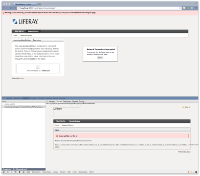Details
-
Type:
 Bug
Bug
-
Status: Closed
-
Priority:
 Minor
Minor
-
Resolution: Fixed
-
Affects Version/s: 3.3, EE-3.3.0.GA
-
Fix Version/s: EE-3.3.0.GA_P01, 4.0.BETA, 4.0
-
Component/s: Framework
-
Labels:None
-
Environment:Portlets
-
Assignee Priority:P1
Description
It only seems to be an issue with portlets but when the session expires, I'm seeing the Network Connection Interrupted popup appear. Logging on the server indicates that session expiry has occurred. I have not been able to see the same issue in non-portlet environment.
Activity
- All
- Comments
- History
- Activity
- Remote Attachments
- Subversion
Assigning to Mircea. I'll try and add more detail on how to reproduce this.
Show
 Deryk Sinotte
added a comment - Assigning to Mircea. I'll try and add more detail on how to reproduce this.
Deryk Sinotte
added a comment - Assigning to Mircea. I'll try and add more detail on how to reproduce this.

Marking fixed pending LiferayFaces 3.1.3-ga4 final release.